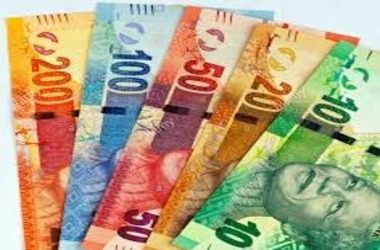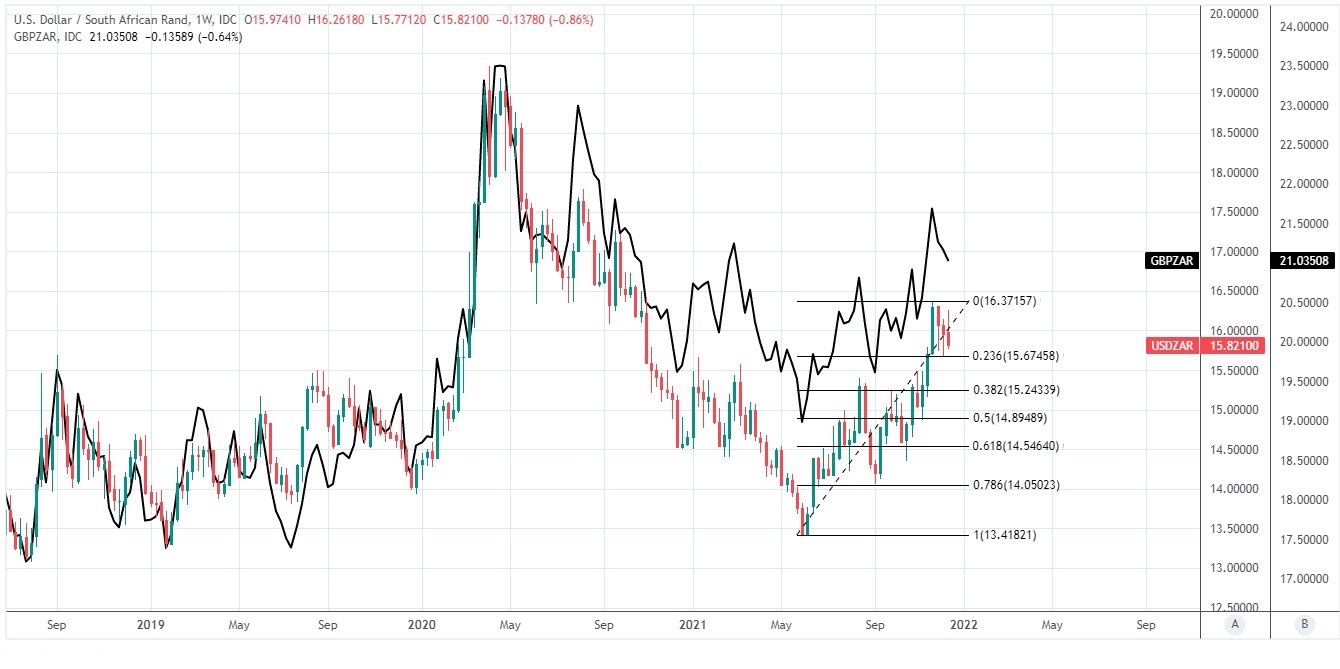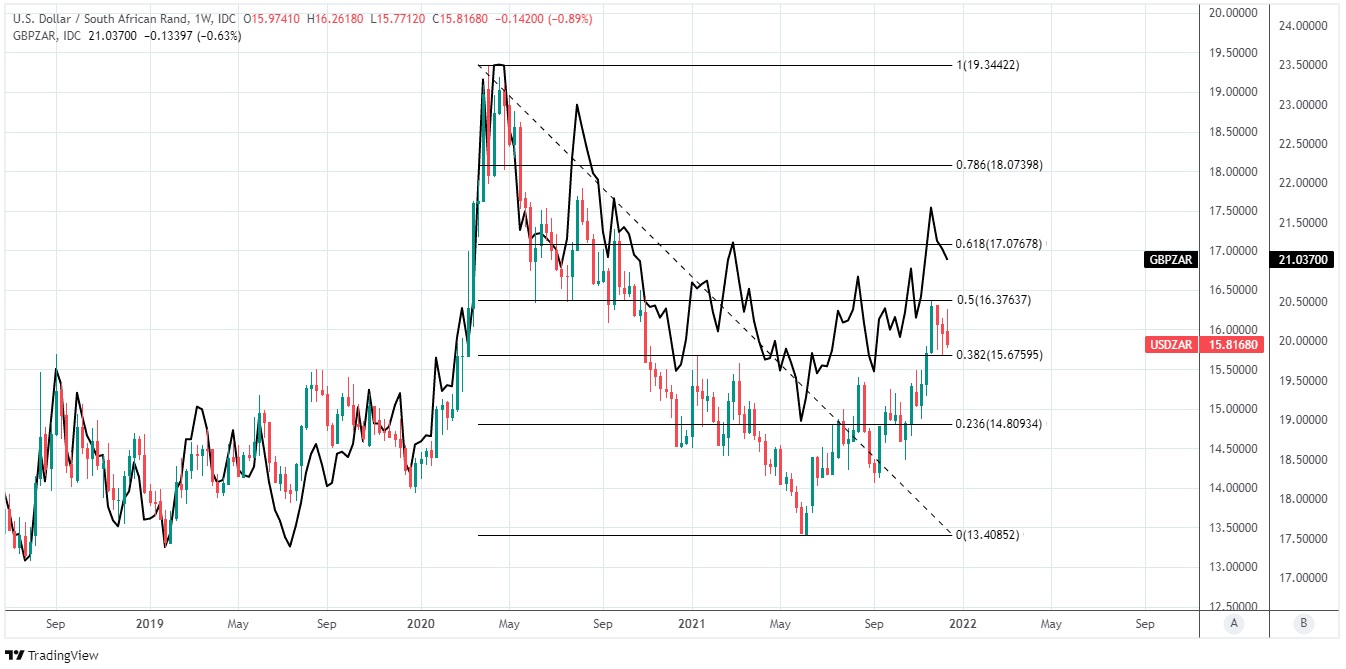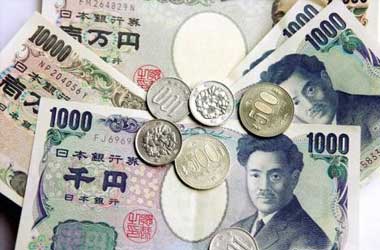 Three consecutive daily advances has assisted in fueling the South African rand to the forefront of the performance rankings amongst key advanced and emerging markets for the week ended December 19. The South African Rand surged all through the second half of the last week, nudging the USD/ZAR exchange rate back towards the base of its December band of 15.70 to 16.36 and, in the pathway, dragging the Pound to Rand rate lower toward 21.00.
Three consecutive daily advances has assisted in fueling the South African rand to the forefront of the performance rankings amongst key advanced and emerging markets for the week ended December 19. The South African Rand surged all through the second half of the last week, nudging the USD/ZAR exchange rate back towards the base of its December band of 15.70 to 16.36 and, in the pathway, dragging the Pound to Rand rate lower toward 21.00.
The USD/ZAR rate fell back towards the base of its December band in the range of 15.70 to 16.36. However, after the Federal Reserve’s policy announcement on Wednesday, the Rand saw three consecutive sessions of advances, putting it on track to retest its November 2021 slumps.
“The revival of the Omicron version in the context of overall USD appreciation has had a negative impact on the ZAR.” The new variation carries with it more economic uncertainty, and the Fed’s tapering might be detrimental to the ZAR’s value. According to Murat Toprak, a CEEMEA foreign exchange analyst at HSBC, “latest ZAR depreciation has indeed mirrored these concerns.”
“Our assessment measures indicate that the ZAR is in accordance with its basics,” says the author. The latest considerable increase in the value of the US dollar against the South African rand reflects a lower current account excesses.
After reviewing HSBC’s Rand predictions a few days before, Toprak concluded that there was “no underlying rationale” for the South African currency to continue to weaken.
With statistics released on Thursday confirming that inflationary pressures in South Africa stayed modest in November, the Rand’s tentative recovery was maintained, with the headline inflation rate remaining only 30 basis points over the bottom of the 3% to 6% target range.
The consequences of restrained domestic demand front constraints are reflected in core inflationary pressure, which grew modestly but stayed fairly tame at 3.3 percent year on year, according to Lara Hodes, an economist at Investec. As a result of these factors, the South African Reserve Bank (SARB) has indeed been sluggish to raise its benchmark rate, and it is possible that it will tend to fall behind as rest of the central banks in advanced and emerging countries normalize their monetary guidelines.
When the South African Reserve Bank raised its benchmark rate from 3.5% in 2020 to 3.75% in November, it said that its quarterly projection figure recommended another interest rate hike before the end of 2021, accompanied by a single 25 basis point hike in the benchmark rate in every quarter of 2022, 2023, and 2024, based on historical data.
“In our opinion, the central bank has maintained its conservative stance by initiating a prudent rate rise sequence. The SARB does not require to be proactive (HSBC economics predicts that the policy rate will be 5.00 percent by the end of 2022, up from 3.75 percent today) since inflationary pressure is expected to stay within the target band of 3% to 6% for the foreseeable future.
This is a significant distinction from other nations in Central and Eastern Europe and the Middle East, where inflationary pressure is considerably over central banks’ objectives,” says HSBC’s Toprak.

The Rand’s fragile rebound comes against the backdrop of a melded showing by the Dollar, despite the Federal Reserve’s announcement on Wednesday to accelerate the scaling back of its quantitative easing program and to prepare to increase benchmark rates as early as 2Q22. The Federal Reserve’s most recent predictions indicated that it may increase interest rates as much as three times in 2022, raising the Federal Funds rate to a range of 0.75% to 1%, but financial markets have not yet priced in such a large scale of change.

That is yet another possible stumbling block for the Rand’s rebound from late November’s nadir that has already encountered Dollar investors at the 15.70 mark this month. In addition, the 23.8 percent Fibonacci retracement of the USD/five-month ZAR’s rally going back to June corresponds with the period when the Federal Reserve first started to suggest that its monetary policy position was starting to change in a less favourable direction, which occurred in late June.
“The trading band is in the region of 15.70 to 16.36. Our preference continues to be to purchase dollars when they are on the down,” according to Yuliya Kryzhanovska, a dealer at Credit Suisse. “Also on franchise side, we have observed dollar dumping by leveraged brands,” according to a trading desk remark published on Wednesday afternoon.




